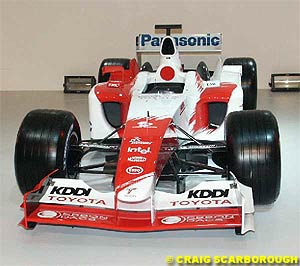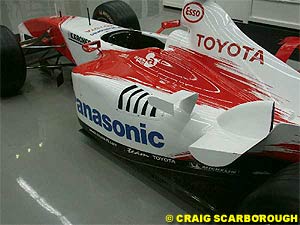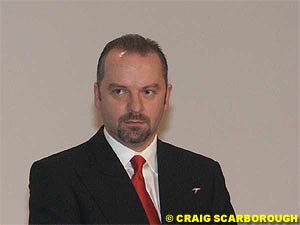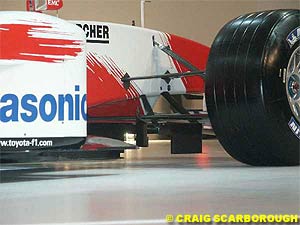
Atlas F1 Technical Writer
The Toyota team start their third year in Formula One with revived hopes, bigger ambitions, a new management and, above all, a completely new car. But will the new Japanese racer be up to the team's demands? Atlas F1's Technical Writer Craig Scarborough takes a closer look at the TF104
Last Season
Toyota spent their second full season in F1 last year with a third or more of their engineers having tested a car continuously in 2001. Many teams are often hit by the spectre of a bad second year after a surprisingly good first year. This syndrome perhaps did not hit Toyota; they had a mediocre first year, and as such 2003 was similar, albeit with a little extra success.
Perhaps the biggest breakthrough came when work to detect the problem running over kerbs was finally successful. Initially thought to be a suspension problem, the drivers struggled with the handling as the front or rear wheels rode over the kerbs, but an instrumented test car showed the car lost all rear downforce as any wheel rode over the kerb; armed with this knowledge the team resolved the aero deficiency in the front wing, and their late season pace improved dramatically.
Team Management
Now Gascoyne moves into one of the few teams building the full car under one roof; Renault splits their operations over two countries. He has come too late to affect the design and roll out of the new car, but his influence will soon be felt; going forward his impact on the team can only be positive. Still heading the two major design departments are Gustav Brunner with Luca Marmorini on the engine side. Both these men feel happy with Mike's arrival, as it leaves them free to get on with their specific roles.
Car
As the car was unveiled the revised paint job at first confuses, but clearly the car carries over a lot of the design from the late versions of the TF103. Speaking to the designers it's clear the car was planned as an evolution or optimised version of the older car, without the risk of new concepts.
One area not adding weight to the car is a twin keel; the team have stuck to the single keel set up as part of the aero concept, with Gustav Brunner commenting that the twin keel design has been researched, as well as potential new nose concepts, but not for this car. Yet he feels the team still lacks the experience aerodynamically to stray too far from the classic layout exhibited so far.
In other areas the car has carried over the forward mounted bargeboard design from the late version of the TF103. Head aerodynamicist Rene Hilhorst explained the change was found from gains detected in CFD simulations, which filtered through to the windtunnel program. The resulting turning vanes use a very small surface area, being mounted completely below the front suspension, in contrast to Williams or BARs larger versions.
Also the crash wings, as Brunner describes them, are a development from 2003. These low fins in front of the sidepods gather and route the air from the splitter around the sidepods; their outermost point is now joined to the floor. In windtunnel testing a two bladed fin has been tried, and will no doubt be track tested in the near future.
Continuing the optimising of the previous car are the sidepods; while still using radiators mounted at a compound angle the coke bottle shape is slimmed even further, with the large flip up being double-skinned to blend smoothly into the sidepod, improving the flow where they join. Winglets,
One issue facing all teams is the loss of 5% of the rear downforce due to the reduction in rear wing elements; this has been cut to around 2%, and the action of the lower wing mounting beam has become more crucial in balancing the downforce front to rear.
Engine
Last year Toyota came in for a lot of praise for the engine, even if the reason for some of this praise should perhaps be attributed to the cars aerodynamics. Regardless, Toyota has an engine near the top of the league. Largely reliable, the rules to limit the team to one engine per weekend "was really a challenge" according to its designer Luca Marmorini, adding it was "crazy" to ask an F1 engine to run for over 800Kms.
Still, the rules were released in plenty of time to warn the designers, even if the detail of the rules had yet to be clarified. With the notice given the team never started work on a conventional short life engine for 2004, going straight into the development of the 800Km version. With such a huge transfer of the team's engine development resources directed towards the 2004 engine it was expected to harm the 2003 ongoing program. It worked out to be quite the opposite; an aggressive 2004 development plan saw parts destined for the RXV04 transferred onto the RXV03 and raced in the later races of the year.
These development parts were not merely details, but major parts like castings and reciprocating parts. This way the 2003 engine was developed into a reliable unit, and the work for the 800Km rule was completed by October. This strategy placed them ahead of even BMW, who only ran a test engine in October, rather than a full power race ready unit. Winter development refined the progress made in the latter half of the season. The resulting engine came in at a similar size and, amazingly, a lighter weight than the RXV03.
Weight was taken from less critical components and added to the parts that needed extra weight. Marmorini noted that adding weight can also add unreliability to certain parts, for example the piston is deeper than the 03 version but is similar in weight due to its design.
Marmorini also expanded on his concept of reliability; while most people's opinion of unreliability is a part breaking or a blow up as a 100% failure, Toyota regard reliability to a finer percentage; he felt that an engine that loses 1-2% of its power by the end of the race is not regarded as reliable, that a 9-18hp loss could make the difference towards a races end. Equally an engine that needs more oil late in a race is not reliable, as the extra weight in oil should be considered part of the engine; the 2kg penalty in 2 litres of oil consumed could be avoided with less than a kilo added in engine development.
Should the claims be true of a reliable RXV04 engine matching the 03 version in size, power, revs and weight the 2004 season should see Toyota continue as one of the top engine producers in F1.
Mechanicals
Designed in an office next door to the engine department the gearbox is all new for 2004; adopting seven gears and a cast titanium casing, the unit is a major departure for the team, especially as all the gears and internals are made in house, not contracted out to Xtrac, Staffs or Hewland.
Brunner noted that the ratios are narrow and light. Work on the casing has made it shorter, lower, stiffer and, crucially, clean sided, as the narrow sidepods focus more flow in this area. Currently the car is using only one carbon wishbone with the other in steel, while vibration and temperature logging is being completed for a possible carbon replacement later in the year. Mated to the suspension are Toyota's trademark skeleton shaped uprights, manufactured by MMC. Up front the suspension and steering are developed from the TF103.
With the team's resources, and new technical partner Denso, they are moving into producing their own electronics; while Magneti Marelli are still a partner, some of the "black boxes" are now made in house. This diversifying into electronics extends to the steering wheel; contained within its new moulding is a colour screen; quite how the benefit of such a device in a busy F1 cockpit is to be realised is not clear.
 After avoiding the curse of a bad second season Toyota, the team with the most potential to break into the top four, revealed their all new car for 2004. While the car looks a lot like its predecessor the problems in its forebear have been understood and redesigned. Toyota's resulting TF104 is a completely new design, with nothing carried over from the TF103; even the wheels, pedals and steering wheel are new. Going into the new season they also boast a new Technical director in Mike Gascoyne, who will tap into the resources and potential of the team. Lastly the engine team went about the work of ensuring the engine lasts all weekend with a development programme dovetailed into its 2003 programme; the engine ended the year ready for the new rules and still had a winter of development ahead of it.
After avoiding the curse of a bad second season Toyota, the team with the most potential to break into the top four, revealed their all new car for 2004. While the car looks a lot like its predecessor the problems in its forebear have been understood and redesigned. Toyota's resulting TF104 is a completely new design, with nothing carried over from the TF103; even the wheels, pedals and steering wheel are new. Going into the new season they also boast a new Technical director in Mike Gascoyne, who will tap into the resources and potential of the team. Lastly the engine team went about the work of ensuring the engine lasts all weekend with a development programme dovetailed into its 2003 programme; the engine ended the year ready for the new rules and still had a winter of development ahead of it.
 The TF103 raced last year suffered many of the same traits as the TF102 the year before. It had a great power output and impressive straight-line speed, but over the kerbs and bumps it suffered poor handling, and reliability was also suspect. Aerodynamics were developed throughout the year as their wind tunnel gained accuracy, and the team reaped the benefits. Several steps were introduced as familiar features disappeared, such as the hot air outlets ahead of the rear wheels, while the front wing and bargeboard combination saw a late season switch to a "W" format wing and forward mounted bargeboards.
The TF103 raced last year suffered many of the same traits as the TF102 the year before. It had a great power output and impressive straight-line speed, but over the kerbs and bumps it suffered poor handling, and reliability was also suspect. Aerodynamics were developed throughout the year as their wind tunnel gained accuracy, and the team reaped the benefits. Several steps were introduced as familiar features disappeared, such as the hot air outlets ahead of the rear wheels, while the front wing and bargeboard combination saw a late season switch to a "W" format wing and forward mounted bargeboards.
 Regardless of how the design for the car turned out, the biggest technical innovation at Toyota this year has been the hiring of Mike Gascoyne. While Toyota has had the experience of Andre De Cortanze and Gustav Brunner to set up the operation, neither man was able to both lead the team and design. Of course De Cortanze left in summer 2001, replaced by Brunner who took on the new car's development and the teams operations at races. But by Brunner's own admission he is a designer rather than a manager; the complex role of directing a large technical team is a specialist one. There are few people in the pitlane able to do this to the potential level Toyota needed. When Gascoyne's position at Renault looked negotiable, Toyota took him on.
Regardless of how the design for the car turned out, the biggest technical innovation at Toyota this year has been the hiring of Mike Gascoyne. While Toyota has had the experience of Andre De Cortanze and Gustav Brunner to set up the operation, neither man was able to both lead the team and design. Of course De Cortanze left in summer 2001, replaced by Brunner who took on the new car's development and the teams operations at races. But by Brunner's own admission he is a designer rather than a manager; the complex role of directing a large technical team is a specialist one. There are few people in the pitlane able to do this to the potential level Toyota needed. When Gascoyne's position at Renault looked negotiable, Toyota took him on.
 In layout the car keeps the same wheelbase but the whole car has been shifted backwards, shortening the rear to give more space at the front. While this gives space for the front wing and bargeboards to work it shifts weight undesirably rearward; this has to be countered with ballast placed above the shadow plate. Toyota have not gone as far with this as Ferrari, but have created more volume to house the tungsten. The weight deficit in the car to allow more ballast has been made up mainly in the chassis and gearbox, with improved techniques in carbon lay-ups and an all-new cast titanium gearbox.
In layout the car keeps the same wheelbase but the whole car has been shifted backwards, shortening the rear to give more space at the front. While this gives space for the front wing and bargeboards to work it shifts weight undesirably rearward; this has to be countered with ballast placed above the shadow plate. Toyota have not gone as far with this as Ferrari, but have created more volume to house the tungsten. The weight deficit in the car to allow more ballast has been made up mainly in the chassis and gearbox, with improved techniques in carbon lay-ups and an all-new cast titanium gearbox.
 While twin keels have not been used to improve flow under the nose the shape of the chassis ahead of the sidepods has been waisted to shrink around the drivers hips, creating space to manage the airflow over the splitter and around the sidepods.
While twin keels have not been used to improve flow under the nose the shape of the chassis ahead of the sidepods has been waisted to shrink around the drivers hips, creating space to manage the airflow over the splitter and around the sidepods.
 cooling and exhaust designs are similar to 2003. To conform to the new rear bodywork regulations the engine cover has been raised to form a tall fin being cut off in line with the rear axle; a longer tail was tried but this solution worked just as well and had better aesthetics, according to Hilhorst. The only disturbance to the low and narrow rear end is the blister to house the rear third damper, this year mounted much lower due to the adoption of Sachs radial dampers, neatening the rest of the rear suspension layout.
cooling and exhaust designs are similar to 2003. To conform to the new rear bodywork regulations the engine cover has been raised to form a tall fin being cut off in line with the rear axle; a longer tail was tried but this solution worked just as well and had better aesthetics, according to Hilhorst. The only disturbance to the low and narrow rear end is the blister to house the rear third damper, this year mounted much lower due to the adoption of Sachs radial dampers, neatening the rest of the rear suspension layout.
Please Contact Us for permission to republish this or any other material from Atlas F1.
|
Volume 10, Issue 3
Articles
A Farewell to Arms?
Technical Analysis: Toyota TF104
Technical Analysis: Jaguar R5
Interview with Ron Tauranac
2004 Countdown: Facts & Stats
Columns
The Fuel Stop
The F1 Trivia Quiz
On the Road
Elsewhere in Racing
> Homepage |